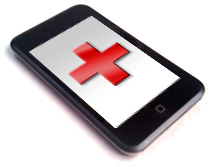By Jason P
Last week, we looked at the possibilities of mHealth: Portable, net-connected devices which can monitor your health in realtime, and provide a new level of connection to your healthcare provider while offering new freedom and mobility to chronic-care patients.
There are a few articles this week about the nexus of mHealth, the smartphone. Not only does the smartphone provide the connectivity that we need for mHealth, but it can run the programs, or apps, that make it all possible.
An article in HealthcareITNews summarizes an report that predicts mHealth apps will triple in number by 2012. There are currently around 200 million mHealth applications in use now, and by next year, there should be 600 million patients who trust some of their medical care to the app on their smartphone or other mobile device.
Even as medical device manufacturers scramble to innovate new hardware for mHealth services, and tablets and netbooks flood the consumer market, it is starting to look like the smartphone will dominate over other hardware form factors. After all the tablet buzz last week at the Consumer Electronics Show, an industry survey, reported here, indicates that smartphones will emerge as the hardware of choice for mHealth.
Another interesting prediction this week concerns app distribution. Current app sources, like the Apple App Store and the Android Marketplace, may be replaced by doctors and hospitals and pharmaceutical manufacturers distributing their own app directly to patients. According to this article in eGov Monitor, your doctor may need to write you a prescription for some pills, and an app.








